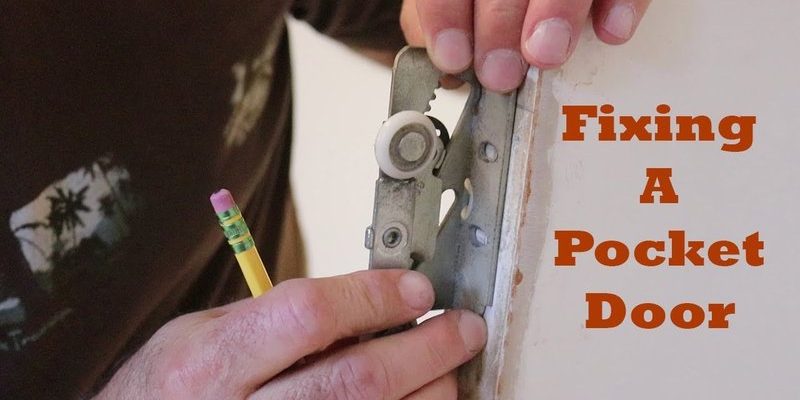
If you’re new to pocket doors, it’s essential to know that they rely on a simple but clever track system. When everything is working well, they glide open and shut without a hitch. But when they don’t fully retract, it can feel like you’re wrestling with a door rather than enjoying the convenience it offers. Let’s dive into how to fix a pocket door that doesn’t fully retract into the wall, and get it back to smooth sailing.
Understanding Pocket Doors
Before we jump into the fix, let’s first nail down what a pocket door is and how it operates. Pocket doors are sliding doors that disappear into a wall cavity, providing a sleek, modern look to your home. They’re commonly used in smaller spaces where swinging doors might take up too much room.
These doors slide along a track, which helps them glide smoothly back and forth. Over time, various factors can affect their operation. It could be anything from misalignment to debris stuck in the track. Visualize the door like a train on its tracks; if the track is off, the train (or door) struggles to move where it should.
Common Reasons for Pocket Door Malfunction
Now that you have a basic understanding of the door’s mechanics, let’s look at the common culprits behind a pocket door that doesn’t fully retract.
- Misaligned Track: The track may have shifted over time, causing the door to stick.
- Obstructions: Dirt and debris can accumulate in the track, obstructing the door’s path.
- Worn Rollers: The rollers can wear out, making it hard for the door to glide smoothly.
- Improper Installation: If the door wasn’t installed correctly, it might not fit the track as intended.
Identifying the problem is half the battle. Next, let’s go through some steps to troubleshoot these issues.
Step 1: Inspect the Track and Rollers
The first step in fixing your pocket door is to inspect the track and rollers. Start by sliding the door back and forth gently. Notice where it struggles. If it sticks, chances are something is off with the track.
To inspect, you’ll want to look closely at the following:
- Check for Obstructions: Run your fingers along the track to feel for dirt or debris. A quick cleaning can do wonders!
- Visual Alignment: Stand back and look at the door. Does it seem to sit level? If it’s higher on one side, it may need alignment.
- Roller Condition: If you can see the rollers through an opening, check if they’re worn down. They should look smooth and intact.
By carefully inspecting these elements, you can get a clearer idea of what might be causing the issue.
Step 2: Cleaning the Track
If you found debris in the track, cleaning is a crucial next step. Here’s how to do it effectively:
1. Tools Needed: Grab a small, handheld vacuum or a soft brush.
2. Remove Debris: Use the vacuum or brush to remove any dirt or grime stuck in the track.
3. Wipe Down: Take a damp cloth and wipe the track to remove any remaining residue.
It’s like giving your door a mini spa day! A clean track allows for smoother movement.
Step 3: Fixing Misalignment
If your pocket door still doesn’t move right after cleaning, misalignment might be the problem. Here’s how to fix it:
1. Loosen Track Brackets: Locate the screws securing the track to the wall. Loosen them slightly but don’t remove them.
2. Realign the Track: Gently nudge the track until the door sits evenly.
3. Tighten the Screws: Once aligned, tighten the screws back into place.
By adjusting the track, you’re helping the door glide more freely, like putting the train back on its tracks.
Step 4: Checking and Replacing Rollers
If you’ve addressed the track yet the door still struggles, it might be time to check the rollers. Here’s what to do:
1. Access the Rollers: Remove the door from its track, which might require lifting it up and out.
2. Examine the Rollers: Look for signs of wear or damage. If they’re rough or chipped, it’s time for a replacement.
3. Replace Rollers: Head to a hardware store to find the right replacement rollers. Installation is generally straightforward—simply slide the new ones into place before hanging the door back.
New rollers can breathe fresh life into your pocket door, making it feel almost brand new.
Step 5: Ensuring Proper Installation
Lastly, if all else fails, consider whether the door was installed correctly in the first place. An improperly installed door can lead to ongoing issues. If you suspect this is the case, you might need to:
– Remove the Door: Take it down and revisit the installation instructions.
– Check the Measurements: Ensure the door fits the opening and has the right clearance.
– Reinstall Carefully: Follow the manufacturer’s instructions closely. Sometimes, a little patience goes a long way.
Final Thoughts
Fixing a pocket door that doesn’t fully retract into the wall can be a rewarding DIY project. With a little patience and the right tools, you can troubleshoot and tackle common issues like misalignment or debris in the track.
Remember, it’s all about understanding your door’s workings and taking the steps necessary to keep it gliding smoothly. If you continue to face problems, don’t hesitate to reach out to a professional for a deeper look. After all, sometimes a bit of expert help is worth it for the peace of mind. You’ve got this!
